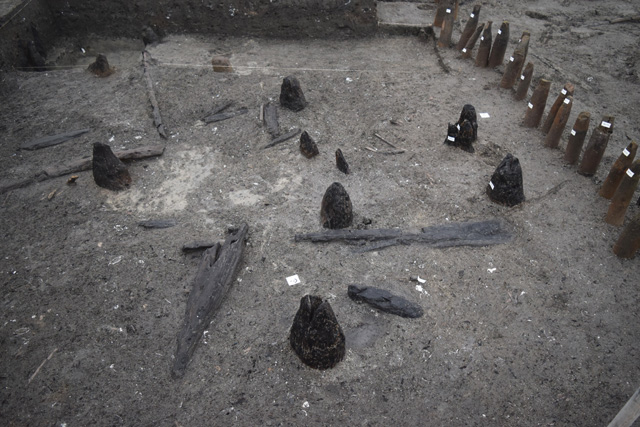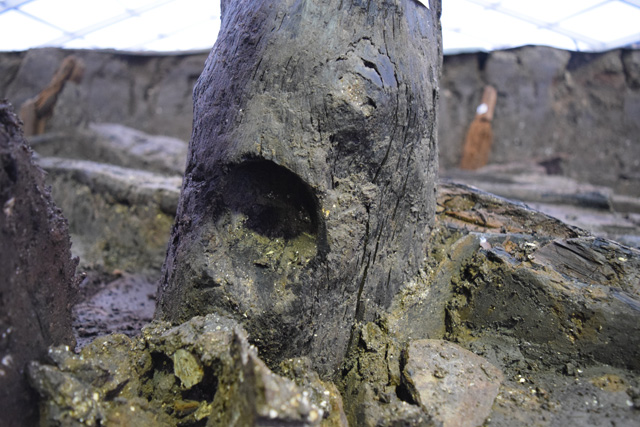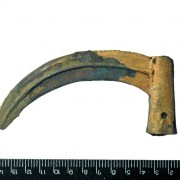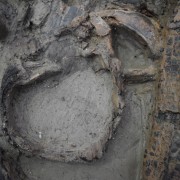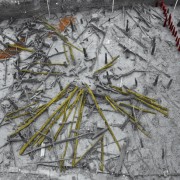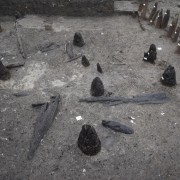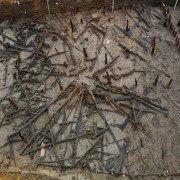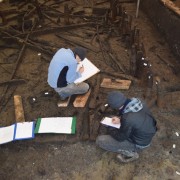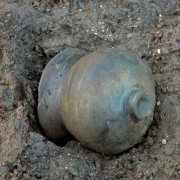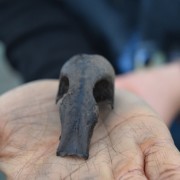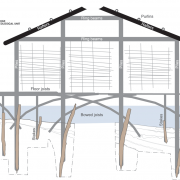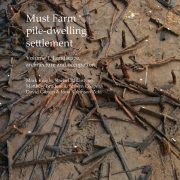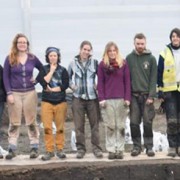Dig Diary 13: Exploring Our Earlier Oak Post Alignment
January 18, 2016
What exactly is our post alignment?
During the 2006 evaluation we came across a number of very substantial, oak posts or piles. These were enormous, worked timbers that were driven deep into the sediments of the river channel. However, given the small snapshot of the site, resulting from the narrow evaluation trenches, it was difficult to understand what these large oak piles belonged to. Thankfully, the current open-area excavation has allowed us to put these significant timbers in context.
Soon after we began to remove the upper shell deposits in the northeast and southwest quadrants of the central area of site we found more of these oak piles. As the project progressed and we got steadily further into the deeper contexts, it became clear how different these timbers were from the uprights of the building and the ash stakes of the palisade. Dating evidence from the evaluations establishes these piles as the earliest elements of the site with felling dates between 1290BC – 1250BC. So, if these piles weren’t part of a building and were especially early, what did they belong to?
The evidence suggests they formed part of a larger post alignment very similar to the one found a mile-and-a-half away at Flag Fen. The dates of the earliest posts from both sites are only a few years apart and their appearance is incredibly similar. Flag Fen’s post alignment was a causeway bridging a watery gap between dry land to the north of the Flag Fen basin. The timbers we have on site seem to have formed a causeway that would have served a similar purpose to the east.
Unveiling the extent of this alignment of large oak piles was something of a surprise, especially given the number we have revealed so far. It seems extremely unlikely that the location of the main settlement so close to this wooden causeway was a coincidence. We are still working to articulate the exact nature of the relationship between these two aspects of the site, but already interesting questions are becoming apparent.
The Flag Fen causeway, bridging a wet environment, seems to have been a route way through the Fenland landscape. Owing to the similarity in form, it is probable that our own wooden causeway served a similar function. The post alignment at Must Farm was above a wet landscape and happened to bridge the channel the buildings are constructed above. We know that the river itself would have been an important route through the Fens at this time. Is our settlement constructed at a “crossroads” of the river and the causeway?
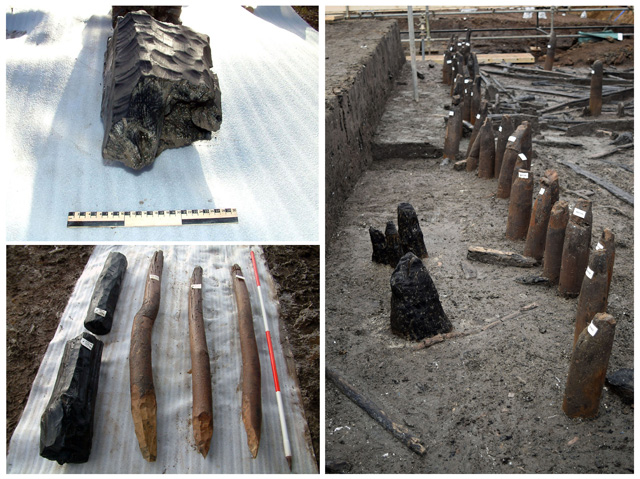
Image showing the difference in scale between the large oak piles and the smaller, ash palisade posts. Upper left image shows the tool markings present
Constructing the causeway would have been an enormous undertaking, especially for the later Bronze Age. It would require coordination and management of a very significant number of people and clearly would have made a huge impact on the landscape. The oak piles that were excavated during the evaluation were all fairly heavily worked and shaped, displaying large quantities of very distinctive tool marks. Each of the timbers was slightly squared and tapered to a blunted point. The remnants of this shaping is lots of fairly deep “scallop” marks left from the axes used to make them, which is incredibly prominent on many of the piles.
Many of the biggest oak timbers also have relatively deep, curved indentations in several places along their lengths. It is not entirely clear what purpose that these unusual removals were for, but it has been suggested they are the remnants of handles. Transporting a timber of this weight and size would have been a very difficult process and carving out a series of hand holds and grips would have undoubtedly helped with moving them into position. We are expecting most of the new oak piles we have discovered during the current excavation to have similar features carved into them.
When the ash palisade was constructed to enclose the settlement at some point between 1000BC – 800BC something extremely fascinating occurs: the palisade does not respect the post alignment. When the ash posts go into the channel they cut completely across the line of large oak piles. This strongly suggests that the causeway has fallen out of use at some stage between the construction of the settlement and the palisade.
Whatever the case, the people living at the settlement no longer seem to find the causeway significant. If they did, then it is very unlikely the palisade would run directly across its alignment. Further evidence to support this idea of the causeway no longer being in use is the position and condition of many of the oak piles. While the ash palisade is uniform and in remarkably good condition, several of the causeways substantial timbers have fallen, some completely horizontally. This suggests that parts of the causeway could have collapsed, as we excavate further we’ll get a much clearer idea of this aspect of the site.
The Must Farm project keeps surprising us with more and more insights into the later Bronze Age. Not only do we have a settlement but a wooden post alignment that is extremely similar to the one discovered at Flag Fen. Thanks to the level of secure archaeological stratigraphy resulting from our river silts, we have great contextual detail and can easily separate out these two elements of our site. By the end of the excavation we should be able to have a good understanding of how the causeway and the settlement related to one another.
Related stories
Dig Diary 16: Earlier and Later Periods in the Fenland Basin
February 8, 2016
Dig Diary 15: Exploring the Occupation Deposit
February 1, 2016
Dig Diary 14: Excavating our Structures
January 25, 2016
Dig Diary 13: Exploring Our Earlier Oak Post Alignment
January 18, 2016
Dig Diary 12: Discovering Our First House
January 11, 2016
Dig Diary 11: The Importance of the Wood Record
January 4, 2016
Dig Diary 10: Looking Further Afield
December 21, 2015
Dig Diary 9: The Site and its Environment
December 14, 2015
Learn more
About
The Must Farm pile-dwelling settlement was excavated by the Cambridge Archaeological Unit with funding from Historic England and Forterra.Publications
Read the Open Access publications the Must Farm pile-dwelling settlement: Volume 1. Landscape, architecture and occupation and Volume 2. Specialist reports.Post-Ex Diaries
Our work on-site has finished but lots more investigation is taking place as we study both the material and the evidence we recovered. ...read more
Discoveries
See some of the discoveries from the Must Farm pile-dwelling settlement.
Making Must Farm
Find out about our work with AncientCraft recreating Must Farm’s material.
FAQs
Further information on the Must Farm project.

